The Forgotten Torture Report: It’s Ten Years Since the Publication of the Senate Armed Services Committee’s Pioneering ‘Inquiry into the Treatment of Detainees in US Custody’
 Please support my work as a reader-funded journalist! I’m currently trying to raise $2500 (£2000) to support my writing and campaigning on Guantánamo and related issues over the next three months of the Trump administration. If you can help, please click on the button below to donate via PayPal.
Please support my work as a reader-funded journalist! I’m currently trying to raise $2500 (£2000) to support my writing and campaigning on Guantánamo and related issues over the next three months of the Trump administration. If you can help, please click on the button below to donate via PayPal.
On December 9, I published an article marking the 4th anniversary of the publication of the executive summary of the Senate Intelligence Committee’s report into the CIA’s detention and interrogation program, a five-year, $40 million project that demonstrated that torture was “not an effective means of acquiring intelligence or gaining cooperation from detainees”, that the interrogations “were brutal and far worse than the CIA represented to policymakers and others,” that the CIA made “inaccurate claims” about the “effectiveness” of the programme in an attempt to justify it and that it “led to friction with other agencies that endangered national security, as well as providing false statements that led to costly and worthless wild goose chases,” as I explained in an article at the time for Al-Jazeera.
With peoples’ minds still, hopefully, focused on questions of accountability, I also wanted to flag up that December 11 marked the 10th anniversary of an earlier report, the Senate Armed Services Committee’s ‘Inquiry into the Treatment of Detainees in US Custody,’ released on December 11, 2008, that, rather than focusing on the CIA, specifically exposed wrongdoing at the highest levels of the Bush administration.
The bipartisan report, issued by the committee’s chairman, Sen. Carl Levin, and its senior Republican, Sen. John McCain, runs to 232 pages, with a 29-page executive summary, and was based on a two-year investigation. In the course of its investigations the committee “reviewed more than 200,000 pages of classified and unclassified documents, including detention and interrogation policies, memoranda, electronic communications, training manuals, and the results of previous investigations into detainee abuse.” The committee also “interviewed over 70 individuals in connection with its inquiry,” mostly DoD, but also DoJ and FBI, “issued two subpoenas and held two hearings to take testimony from subpoenaed witnesses,” sent “written questions to more than 200 individuals,” and also “held public hearings on June 17, 2008 and September 25, 2008,” the transcripts of which, running to 380 pages, can be found here. Read the rest of this entry »
Torture on Trial in the US Senate, as the UK Government Unreservedly Apologizes for Its Role in Libyan Rendition
 Please support my work as a reader-funded journalist! I’m currently trying to raise $2500 (£2000) to support my writing and campaigning on Guantánamo and related issues over the next three months of the Trump administration.
Please support my work as a reader-funded journalist! I’m currently trying to raise $2500 (£2000) to support my writing and campaigning on Guantánamo and related issues over the next three months of the Trump administration.
I wrote the following article for the “Close Guantánamo” website, which I established in January 2012, on the 10th anniversary of the opening of Guantánamo, with the US attorney Tom Wilner. Please join us — just an email address is required to be counted amongst those opposed to the ongoing existence of Guantánamo, and to receive updates of our activities by email.
In the last few days, two very different approaches to torture have been on display in the US and the UK.
On Wednesday, the US Senate conducted confirmation hearings for Gina Haspel, Donald Trump’s nomination as the next Director of the CIA, who has attracted widespread criticism since her nomination was announced back in March, for two particularly valid reasons: firstly, because, towards the end of 2002, she was in charge of the CIA’s first post-9/11 “black site” in Thailand, where several “high-value detainees” were held and tortured, and secondly because, in 2005, she was involved in the destruction of videotapes documenting the torture of prisoners, even though a court had ordered the tapes to be preserved.
At the time of her nomination, we signed up to a letter from a number of rights groups opposing her nomination, and also published an article on our website, entitled, The Torture Trail of Gina Haspel Makes Her Unsuitable to be Director of the CIA. Read the rest of this entry »
British MPs Urge Donald Trump and Senate Committees to Close Guantánamo
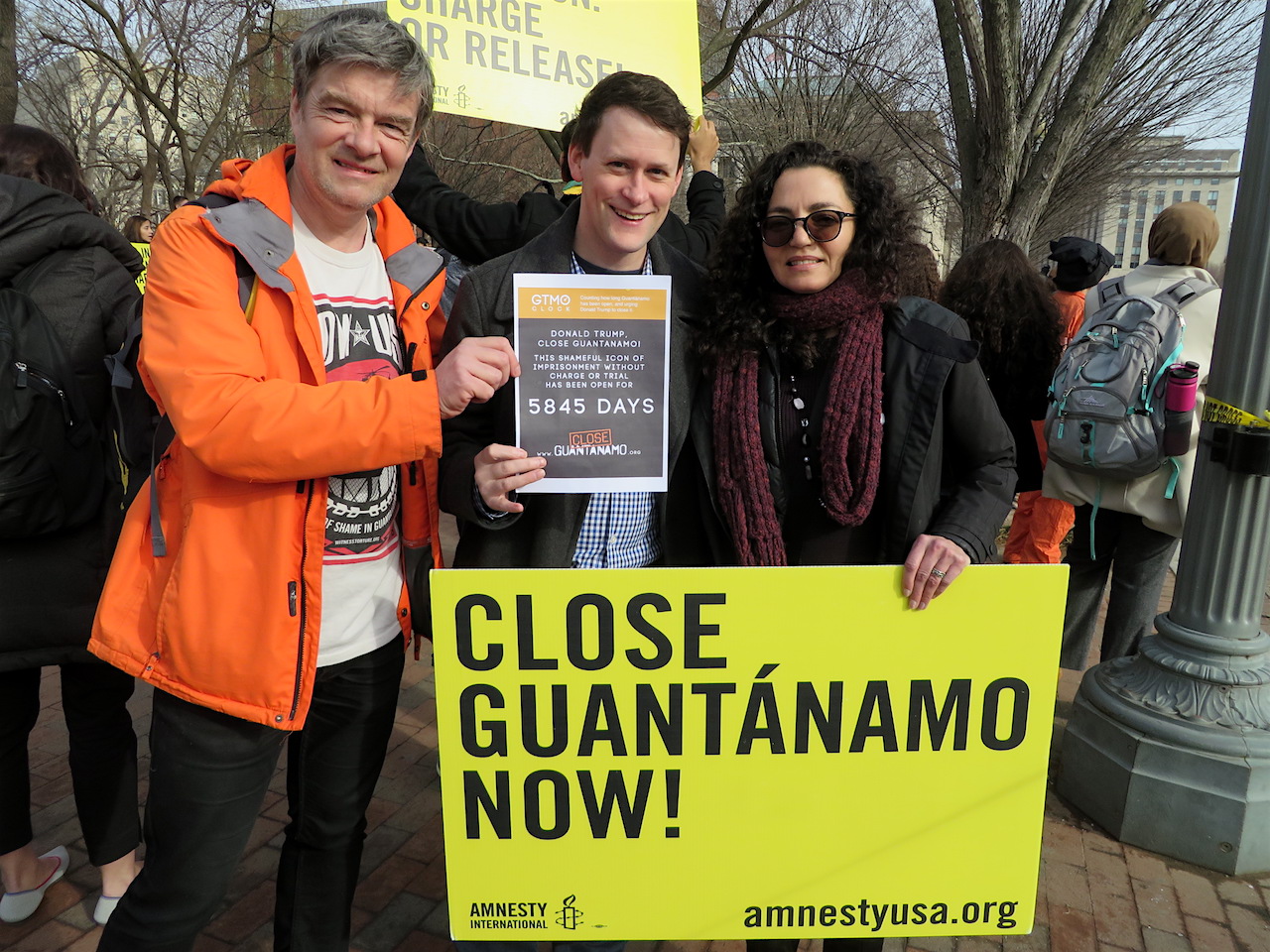 Please support my work as a reader-funded journalist! I’m currently trying to raise $2500 (£2000) to support my writing and campaigning on Guantánamo and related issues over the next three months of the Trump administration.
Please support my work as a reader-funded journalist! I’m currently trying to raise $2500 (£2000) to support my writing and campaigning on Guantánamo and related issues over the next three months of the Trump administration.
I wrote the following article for the “Close Guantánamo” website, which I established in January 2012, on the 10th anniversary of the opening of Guantánamo, with the US attorney Tom Wilner. Please join us — just an email address is required to be counted amongst those opposed to the ongoing existence of Guantánamo, and to receive updates of our activities by email.
For the 16th anniversary of the opening of the prison at Guantánamo Bay, and the first anniversary of Donald Trump’s inauguration, a cross-party group of British MPs have written to Donald Trump, and to Republican Senators John McCain and Bob Corker, the chairs of two influential Senate Committees (the Senate Armed Services Committee and the Senate Committee on Foreign Relations), to urge action on Guantánamo after a year in which no prisoner has been released, despite five of the 41 men still held being approved for release, between 2010 and 2016, by high-level government processes established under President Obama. Throughout 2017, Donald Trump also made it clear that he has no interest in closing the prison, and would like to expand its use.
Almost as soon as Trump took office last January, a leaked draft executive order revealed that he wanted to keep Guantánamo open, wanted to send new prisoners there, and wanted to “suspend any existing transfer efforts pending a new review as to whether any such transfers are in the national security interests of the United States.” He also wanted to reinstate torture and the use of CIA “black sites.”
Trump’s enthusiasm for torture was immediately rebuffed by a wide range of critics, including many in his own administration and his eagerness to send new prisoners to Guantánamo has also not led to any new arrivals at the prison, for sound reasons that we hope remain flagged up throughout the rest of his presidency. Set up to be beyond the reach of the US courts, Guantánamo was never about justice or due process, but about using torture and abuse and then hiding it, and as the troubled history of the military commissions reveals, once prisoners have been tortured, it is difficult, if not impossible to bring them to justice. Trump’s advisers have undoubtedly also told him that US courts have a strong track record of successfully prosecuting those accused of terrorism. Read the rest of this entry »
Detailed Los Angeles Review of Books Article Asks, “What Are We Still Doing in Guantánamo?”
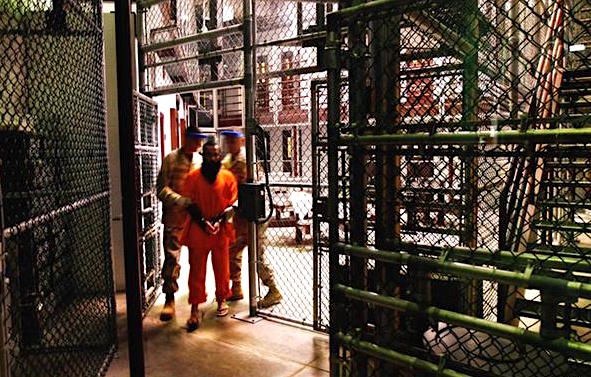 Please support my work! I’m currently trying to raise $2500 (£2000) to support my writing and campaigning on Guantánamo and related issues over the next three months of the Trump administration.
Please support my work! I’m currently trying to raise $2500 (£2000) to support my writing and campaigning on Guantánamo and related issues over the next three months of the Trump administration.
As we approach the 16th anniversary of the terrorist attacks of September 11, 2001, those of us who care about justice, the rule of law and a sense of proportion will also be attempting to remind the world that we’re just four months away from another 16th anniversary, directly released to 9/11 — the opening of the prison at Guantánamo Bay, which took place on January 11, 2002.
Ostensibly a prison for “the worst of the worst,” seized in the “war on terror” that the Bush administration declared in the wake of the 9/11 attacks, Guantánamo has, instead, become, to those who care, a symbol of everything that is wrong with the US response to 9/11 — a place where men seized through dubious intelligence, or bought for bounty payments from America’s allies in Pakistan and Afghanistan, were tortured or abused to make false statements incriminating themselves or their fellow prisoners, and are held, mostly without charge or trial, in defiance of domestic and international laws and treaties establishing how prisoners can only be held if they are criminal suspects facing trials, or prisoners of war protected by the Geneva Conventions,
The Guantánamo prisoners are neither, and are, still, men held essentially without any rights, although unfortunately most people — or most Americans, in particular — neither know nor care, and 15 years and eight months after the prison opened, the 41 men still held are at the mercy of the third president in charge of their fate — Donald Trump, who, rather than accepting that Guantánamo is an aberration that must be closed (as George W. Bush eventually realized, and Barack Obama knew all along, despite lacking the political will to deliver on his promise to close it), intends to officially keep it open, and, if he can manage it, to send new prisoners there — a plan that anyone rational abhors, although, unfortunately, rational thought is currently quite severely endangered, especially, it seems, in the Republican Party. Read the rest of this entry »
Trump’s Dystopian America: The Unforgivable First Ten Days
Please support my work! I’m currently trying to raise $2500 (£2000) to support my work over the first two months of the Trump administration.
Ten days ago, reality as we knew it seemed to disappear with Donald Trump’s inauguration, and the bleak, insular, threatening speech at its heart, which bore all the hallmarks of the miserable white supremacist world view of his most trusted advisor, Steve Bannon, a man who needs constantly exposing as the genuinely malevolent force behind Trump’s throne.
I was in New York City at the time of the inauguration, staying in a house in Brooklyn. My hosts had gone out to work, and I was alone as the realization that no last minute miracle had spared us from Trump truly sank in. I was chilled, and spent the day in a fog of anxiety, as did tens of millions of other Americans.
The following day, the Women’s March played a hugely important role in establishing the resistance to Trump. Millions of women (and supportive men), inspired by opposition to Trump’s misogyny, marched in Washington, D.C., in New York and in other cities across the US and around the world. I wrote about the inspiring New York event here, and my photos are here. Read the rest of this entry »
Donald Trump Proposes to Keep Guantánamo Open, to Prevent Further Releases, and to Reintroduce Torture and “Black Sites”
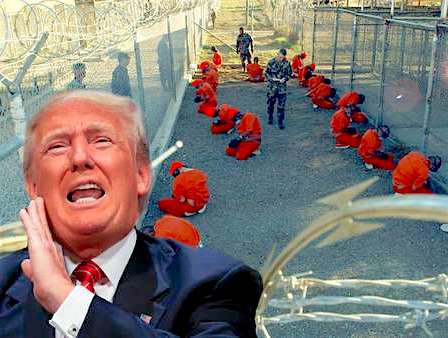 Please support my work! I’m currently trying to raise $2500 (£2000) to support my writing and campaigning on Guantánamo and related issues over the first two months of the Trump administration.
Please support my work! I’m currently trying to raise $2500 (£2000) to support my writing and campaigning on Guantánamo and related issues over the first two months of the Trump administration.
I wrote the following article for the “Close Guantánamo” website, which I established in January 2012, on the 10th anniversary of the opening of Guantánamo, with the US attorney Tom Wilner. Please join us — just an email address is required to be counted amongst those opposed to the ongoing existence of Guantánamo, and to receive updates of our activities by email.
On Wednesday our worst fears on Guantánamo and torture were confirmed, when the New York Times published a leaked draft executive order, “Detention and Interrogation of Enemy Combatants,” indicating that Donald Trump wants to keep Guantánamo open, wants to send new prisoners there, and wants to “suspend any existing transfer efforts pending a new review as to whether any such transfers are in the national security interests of the United States.” Trump also, it seems, wants to reinstate torture and the use of CIA “black sites.”
Specifically, the draft executive order proposes revoking the two executive orders, 13492 and 13491, that President Obama issued on his second day in office in January 2009 — the first ordering the closure of Guantánamo, and the second to close CIA “black sites,” to grant the International Committee of the Red Cross access to all prisoners, and to ensure that interrogators only use techniques approved in the Army Field Manual.
The draft executive order also proposes to “resurrect a 2007 executive order issued by President Bush,” as the New York Times put it, which “responded to a 2006 Supreme Court ruling about the Geneva Conventions that had put CIA interrogators at risk of prosecution for war crimes, leading to a temporary halt of the agency’s ‘enhanced’ interrogations program.” Read the rest of this entry »
Finally, President Obama Vetoes Defense Bill That Contains Onerous Guantánamo Restrictions
 I wrote the following article for the “Close Guantánamo” website, which I established in January 2012 with US attorney Tom Wilner. Please join us — just an email address is required to be counted amongst those opposed to the ongoing existence of Guantánamo, and to receive updates of our activities by email.
I wrote the following article for the “Close Guantánamo” website, which I established in January 2012 with US attorney Tom Wilner. Please join us — just an email address is required to be counted amongst those opposed to the ongoing existence of Guantánamo, and to receive updates of our activities by email.
Last week, for only the fifth time in his Presidency, Barack Obama vetoed a bill sent for his approval by Congress. The bill in question was the draft of next year’s National Defense Authorization Act, which provides funding for the military, but which, for several years now, has also been used by Republicans to impose restrictions on the president’s ability to release prisoners from Guantánamo — as well as an absolute ban on bringing any prisoner to the US mainland for any reason.
In a Veto Message on October 22, President Obama wrote, “I am returning herewith without my approval H.R. 1735, the ‘National Defense Authorization Act for Fiscal Year 2016.'” He added that “the bill would, among other things, constrain the ability of the Department of Defense to conduct multi-year defense planning and align military capabilities and force structure with our national defense strategy, impede the closure of the detention facility at Guantánamo Bay, and prevent the implementation of essential defense reforms.”
On Guantánamo, President Obama wrote, in further detail: Read the rest of this entry »
Does President Obama Still Have a Plan for Closing Guantánamo?
 Recently, there was a brief flurry of media interest in Guantánamo after the New York Times published an article by Charlie Savage entitled, “Obama’s Plan for Guantánamo Is Seen Faltering.”
Recently, there was a brief flurry of media interest in Guantánamo after the New York Times published an article by Charlie Savage entitled, “Obama’s Plan for Guantánamo Is Seen Faltering.”
Savage noted how the Obama administration’s “fitful effort” to shut down the prison at Guantánamo “is collapsing again,” pointing out how, in his first six months as defense secretary, Ashton Carter “has yet to make a decision on any newly proposed deals to transfer individual detainees,” and claiming that, according to unnamed officials, this delay, “which echoes a pattern last year by his predecessor, Chuck Hagel,” is “generating mounting concern in the White House and State Department.” The most recent transfers out of Guantánamo — of six Yemenis resettled in Oman — were in June, but they were part of deal negotiated under Hagel, which saw four other Yemenis rehoused in Oman in January.
Savage wrote that, in mid-July, President Obama’s national security adviser, Susan Rice, “convened a cabinet-level ‘principals committee’ meeting on how to close the prison before the president leaves office in 18 months.” At that meeting, Carter “was presented with an unsigned National Security Council memo stating that he would have 30 days to make decisions on newly proposed transfers,” according to several officials familiar with the discussions. Read the rest of this entry »
The Path to Closing Guantánamo
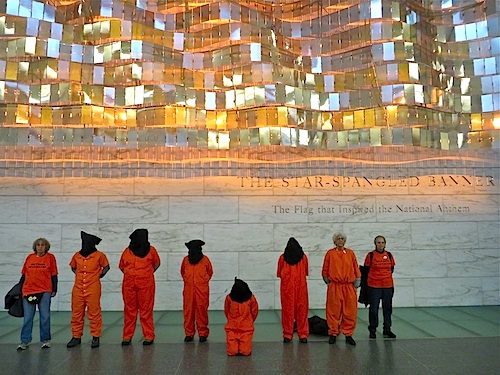 I wrote the following article for the “Close Guantánamo” website, which I established in January 2012 with US attorney Tom Wilner. Please join us — just an email address is required to be counted amongst those opposed to the ongoing existence of Guantánamo, and to receive updates of our activities by email.
I wrote the following article for the “Close Guantánamo” website, which I established in January 2012 with US attorney Tom Wilner. Please join us — just an email address is required to be counted amongst those opposed to the ongoing existence of Guantánamo, and to receive updates of our activities by email.
On Saturday, six Yemenis were freed from Guantánamo, and resettled in Oman, bringing the prison’s population down to 116 men, the lowest total it has been since the first few months of the prison’s operation back in 2002. I wrote about the release of the men here, and amended the details of our prisoner list here, and, in response to the releases, I thought it would also be useful to follow up by looking at where we stand with President Obama’s long-promised mission to close the prison.
President Obama made his promise to close Guantánamo on his second day in office, pledging to close it within a year. Since failing to keep the promise, he has sporadically stated again his desire to see the prison closed — most notably two years ago, when a prison-wide hunger strike prompted him to promise to resume releasing prisoners, after a period of nearly three years in which releases had almost ground to a halt, because of opposition in Congress and the president ‘s refusal to expend political capital overcoming those obstacles.
In April, as I wrote about here, the Washington Post reported, as I paraphrased it, that all the men approved for release in Guantánamo — at the time 57 out of the 122 men still held — would be “freed by the end of the year, and, if Congress proves obstructive, the Obama administration might close the facility before the end of Obama’s presidency by unilaterally moving the remaining prisoners to the US mainland.” I added, however, that, realistically, “it might be wisest to view these suggestions as the administration stating its best-case scenario.” Read the rest of this entry »
New York Times Publishes British MPs’ Hard-Hitting Op-Ed Calling for Shaker Aamer’s Release from Guantánamo
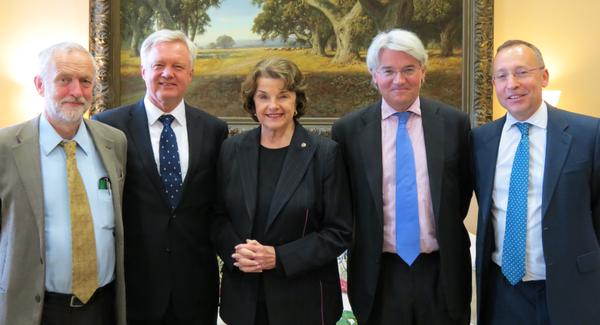 I wrote the following article for the “Close Guantánamo” website, which I established in January 2012 with US attorney Tom Wilner. Please join us — just an email address is required to be counted amongst those opposed to the ongoing existence of Guantánamo, and to receive updates of our activities by email.
I wrote the following article for the “Close Guantánamo” website, which I established in January 2012 with US attorney Tom Wilner. Please join us — just an email address is required to be counted amongst those opposed to the ongoing existence of Guantánamo, and to receive updates of our activities by email.
Regular readers of “Close Guantánamo” will be aware of the case of Shaker Aamer, the last British resident still held in the prison at Guantánamo Bay. Shaker, a Saudi national who was given indefinite leave to remain in the UK, has a British wife and four British children, and is still held despite being approved for release under President Bush in 2007 and under President Obama in 2010.
I wrote about Shaker’s case soon after the “Close Guantánamo” campaign and website was established, on the 10th anniversary of the opening of Guantánamo in January 2012. To mark the 10th anniversary of Shaker’s arrival at Guantánamo, on February 14, 2012, I wrote an article entitled, 10 Years in Guantánamo: British Resident Shaker Aamer, Cleared for Release But Still Held.
One of his lawyers, Ramzi Kassem, then made available notes of his meetings with Shaker, which we published as two articles in April 2012, and again in October 2012, at Shaker’s request. In October 2013, we published an exclusive article about Shaker’s request for an independent medical evaluation, and also published Ramzi Kassem’s supporting statement, and in April 2014, after that medical evaluation had been allowed, we followed up with an article about Shaker’s ultimately unsuccessful request for a judge to order his release because of the findings by the expert, Dr. Emily Keram, that Shaker was suffering from a host of physical and psychological problems. Read the rest of this entry »













 Who's still at Guantánamo?
Who's still at Guantánamo?
